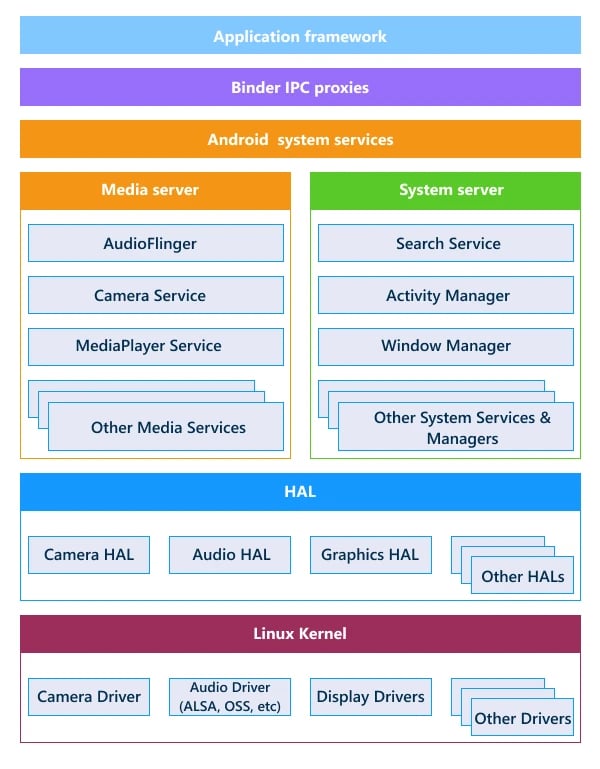
The Android OEM Conundrum: Navigating the Complexities of a Fragmented Ecosystem
The Double-Edged Sword of Openness in Android Development
The Android operating system is a global powerhouse, powering billions of smartphones, tablets, and other connected devices. Its open-source foundation, the Android Open Source Project (AOSP), has fostered a vibrant and diverse ecosystem, allowing manufacturers worldwide to build and customize devices for nearly every price point and niche. This flexibility is Android’s greatest strength. However, it also presents its most significant technical challenge: fragmentation. Unlike a vertically integrated ecosystem where one company controls the hardware, software, and services, the world of Android phones is a complex web of Original Equipment Manufacturers (OEMs), chipset makers, and mobile carriers, each adding their own layer to the final product. This article delves into the technical intricacies of Android phone development from an OEM perspective, exploring the challenges of customization, the hurdles in the software update lifecycle, and the strategic imperatives for succeeding in a market where software experience is becoming the ultimate differentiator.
Understanding the Android Development Landscape: More Than Just an OS
To grasp the challenges OEMs face, one must first understand the multi-layered nature of the software running on modern Android gadgets. It’s not a single, monolithic entity but a stack of components, each contributing to the final user experience and, consequently, the development complexity.
The AOSP Foundation: The Common Ground
At the very bottom is the Android Open Source Project (AOSP). This is the pure, unadulterated version of Android that Google maintains and releases. It contains the core operating system, including the Linux kernel, the Android runtime (ART), system libraries, and a basic set of applications like a browser, dialer, and contact manager. AOSP is the universal starting point for every Android device. In theory, anyone can download the AOSP source code, compile it, and run it on compatible hardware. However, AOSP lacks the proprietary Google Mobile Services (GMS), which includes critical apps and APIs like the Google Play Store, Google Maps, Gmail, and push notifications. For most commercial devices, AOSP is the foundation, not the final product.
The OEM Layer: Customization and Differentiation
This is where the fragmentation truly begins. OEMs like Samsung, Xiaomi, OnePlus, and others take the AOSP code and build their unique software experiences on top of it. This “skin” or custom UI is far more than a simple theme. It involves deep modifications to the system framework, the addition of proprietary features, and the creation of a distinct visual identity.
- Samsung’s One UI: Known for its feature-rich environment, including the DeX desktop experience, deep integration with the S Pen on Note/Ultra devices, and a suite of Samsung-specific applications and services.
- Google’s Pixel UI: While often called “stock” Android, it’s Google’s own OEM skin built on AOSP. It differentiates with exclusive features powered by machine learning, such as Magic Eraser, Call Screen, and advanced computational photography.
- Xiaomi’s MIUI/HyperOS: Historically known for heavy visual modifications inspired by iOS, it includes a wide array of system management tools, themes, and custom applications.
These customizations are essential for brand identity and value-add, but they require significant engineering resources. Every time Google releases a new version of Android, OEMs must merge their extensive changes with the new AOSP codebase, a process that is both time-consuming and prone to bugs.
The Chipset and Carrier Variables

Two other crucial players add to the complexity. First, chipset manufacturers like Qualcomm and MediaTek provide the System on a Chip (SoC) and the low-level drivers that form the Hardware Abstraction Layer (HAL). When Google updates Android, these vendors must first update their drivers before an OEM can even begin their work. Second, in many regions, mobile carriers (e.g., Verizon, AT&T, Vodafone) act as a final gatekeeper. They often require a lengthy certification process for any new software update and frequently bundle their own applications (“bloatware”), further altering the software and potentially delaying rollouts.
The Developer’s Gauntlet: Technical Challenges in a Multi-OEM World
This multi-layered ecosystem creates a minefield of technical hurdles that both OEM engineers and third-party app developers must navigate. What works perfectly on a Google Pixel might behave unpredictably or fail entirely on a device from another brand.
The API and Hardware Abstraction Layer (HAL) Maze
While Google strives to provide standardized APIs for developers, the reality is more complicated. To enable their unique hardware features, OEMs often create their own proprietary APIs or extend existing ones. A prime example is the camera. The standard Android Camera2 API is powerful, but to access the full potential of a sophisticated multi-lens system on a flagship Samsung phone—like seamlessly switching between lenses during video recording or using specific pro-grade controls—a developer might need to use Samsung’s specific SDKs. An app coded to these proprietary APIs will not function correctly on other Android phones, forcing developers to write device-specific code paths or settle for a lowest-common-denominator feature set.
This extends to the HAL. An OEM might use a unique fingerprint sensor or a specialized display component. They must write the custom drivers to make this hardware communicate with the Android framework. This tight coupling of software to specific hardware is a primary reason why providing long-term OS updates is so difficult; if a chipset vendor drops support for an older SoC, it becomes nearly impossible for the OEM to update the device to a new Android version.
The Update Lifecycle Problem: A Chain of Dependencies
The slow pace of Android updates is a perennial topic in Android news and a direct consequence of this fragmentation. The process is a complex relay race:
- Google: Releases the new Android version to AOSP and for its Pixel devices.
- Chipset Vendor: Qualcomm/MediaTek adapts the new OS to work with their SoCs and releases updated drivers to OEMs. This step alone can take months.
- OEM: Merges the new AOSP code and chipset drivers with their custom UI (e.g., One UI). This involves extensive development and testing to ensure thousands of custom features and modifications don’t break.
- Carrier: Receives the OEM’s build and conducts its own network and performance testing. They may request changes or reject a build, adding further delays.
- User: Finally receives the Over-The-Air (OTA) update.
Any delay at any stage holds up the entire chain. This stands in stark contrast to Apple, which controls the entire stack and can push updates to all supported devices simultaneously.
Inconsistent Behavior and Aggressive “Optimizations”
Perhaps the most frustrating issue for app developers is the inconsistent implementation of core Android features, particularly around power management. To boast about longer battery life, some OEMs implement extremely aggressive background process management systems that deviate from AOSP standards. These systems can kill background services essential for an app’s functionality.
- Real-World Scenario: A user starts a run with their favorite fitness tracking app. Twenty minutes in, the OEM’s “battery optimizer” kills the app’s background service to save power. When the user finishes their run, they discover that only the first 20 minutes were tracked.
This unpredictable behavior forces developers to implement complex workarounds and spend countless hours debugging issues that only appear on specific devices, damaging both the developer’s and the OEM’s reputation.

From Challenge to Opportunity: The OEM Strategy for Success
While the challenges are significant, the very fragmentation that causes these issues also provides OEMs with the opportunity to innovate and differentiate. The most successful Android OEMs are those who leverage software to build a compelling and unique value proposition.
Software as a Differentiator: The Pixel and Nothing Approach
Google’s Pixel line is the quintessential example of a software-first strategy. While its hardware is competitive, its primary selling point is the “Pixel experience.” Features like real-time translation, AI-powered photo editing, and intelligent call screening are exclusive software innovations that define the product. Similarly, a newer brand like Nothing has focused heavily on creating a cohesive and unique software identity with Nothing OS, using a distinct design language and thoughtful features to stand out in a sea of similar-looking Android gadgets.
Building an Ecosystem: Samsung’s Playbook
Samsung, the largest Android OEM, competes by building its own comprehensive ecosystem. They understand that the battle is not just phone vs. phone, but ecosystem vs. ecosystem. Through services like SmartThings for home automation, Samsung Health for wellness tracking, and the powerful DeX platform, Samsung creates a sticky environment. A user with a Samsung phone, watch, and earbuds experiences a level of seamless integration that encourages brand loyalty. This strategy transforms their custom software from a simple “skin” into the central hub of a user’s digital life.
The Long-Term Support Promise: A New Battleground

Recently, a new competitive front has opened: software support longevity. Recognizing consumer frustration with short update cycles, leading OEMs like Google and Samsung have committed to providing seven years of OS and security updates for their flagship devices. This is a monumental technical and financial commitment. It requires close collaboration with chipset vendors and a streamlined internal development process. This promise directly addresses a key historical advantage of their main competitor and signals a shift in the industry, where long-term value and reliability are becoming as important as cutting-edge hardware specs.
Navigating the Ecosystem: Best Practices for Developers and OEMs
Success in the fragmented Android world requires a strategic approach from all parties. Here are some actionable best practices.
For App Developers: Defensive and Adaptive Coding
- Embrace Android Jetpack: Use Google’s modern AndroidX libraries whenever possible. They are designed to handle many OS version and device inconsistencies gracefully, reducing the amount of boilerplate and compatibility code you need to write.
- Test on Real Devices: Do not rely solely on emulators. The most problematic bugs and behavioral quirks only surface on real-world hardware. Utilize cloud-based testing services like Firebase Test Lab to run your app on a wide variety of popular Android phones.
- Fail Gracefully: When using an OEM-specific API, always check for its existence before calling it. If the API is not present, your app should fall back to a standard implementation or disable the feature, rather than crashing.
For OEMs: Embracing Standards and Transparency
- Adhere to AOSP Standards: While customization is key, adhering as closely as possible to AOSP’s core functionality and API behaviors can dramatically speed up the update process and improve app compatibility.
- Be Transparent About Optimizations: If implementing aggressive background management, provide clear, user-accessible controls to whitelist essential applications. Document these behaviors for developers to prevent a frustrating guessing game.
- Foster a Developer Community: Provide robust documentation, tools, and SDKs for your proprietary features. Engaging with the developer community can turn your unique hardware into a platform for innovation rather than a source of frustration.
Conclusion: The Path to a Cohesive Future
The development of Android phones is a testament to the power and peril of an open ecosystem. The fragmentation that allows for incredible choice and innovation is the very same force that creates technical debt, update delays, and inconsistent user experiences. The narrative, however, is shifting. The latest Android news and product launches show that the frontier of competition is no longer solely defined by megapixel counts or gigahertz. Instead, the focus is on the intelligence of the software, the strength of the surrounding ecosystem, and the promise of long-term, reliable support. The Android OEMs who will thrive in the coming years will be those who master this complex balancing act—who can innovate and differentiate while simultaneously embracing standards, streamlining their development pipeline, and delivering a software experience that is as reliable and cohesive as the hardware it runs on.



